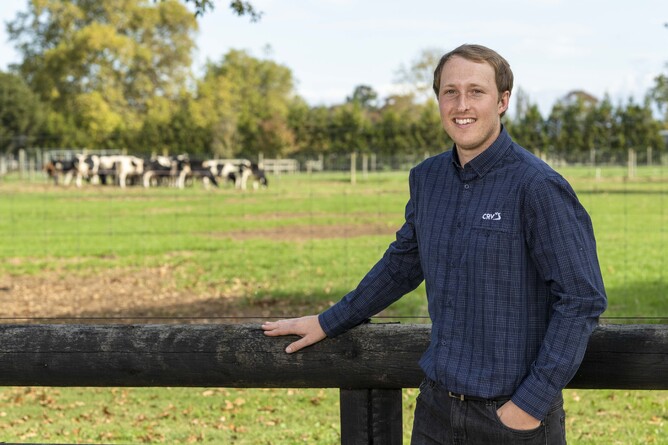CRV’s dairy beef sales have grown by 15% since last year as farmers take a more strategic approach to breeding and look to diversify their income streams.
“In the past, farmers used dairy beef predominantly towards the end of the mating season,” says Genetics Product Manager (NZ Market) Mitchell Koot.
“Now we are seeing more of them using it as part of a more strategic precision breeding approach to increase their herds’ genetic gain.
“That involves using dairy beef strategically over their lowest genetic merit animals, together with sexed and conventional dairy semen over their best performers. This approach helps drive genetic gains even faster and create a healthier, more efficient herd.”
Mitchell says as an increasing number of dairy farmers are recognising the added value of dairy beef calves, they are considering a range of breeds to appeal to the beef market.
“Our dairy beef Fertabull (Hereford, Angus and Belgian Blue) remain the most popular options within the respective breeds to give dairy farmers the best chance of getting cows in calf. Data from CRV recorded herds indicates that farmers are getting up to 4% higher non return rates using Fertabull.”
CRV currently has 20 breeds of dairy beef for farmers to choose from. These range from breeds with easy to identify coat markings, such as Hereford and Belgian Blue, to breeds with high growth rates that appeal to beef finishers, such as Charolais, Angus and Stabilizer.
Dairy Beef sires breeding values are screened carefully for short gestation, growth rates and calving ease along with other key traits. Short gestation is important as it allows the calving pattern to be in line with earlier mated animals in the dairy herd.
CRV works with key dairy beef partners to ensure they offer customers top quality sires whose progeny have traits tailored to both dairy and beef farmer needs.
Belgian Blue
CRV offers sires from the Belgian Blue Group (BBG) in Belgium. The size of the Belgian Blues comes from the breed’s double muscle gene, which is completely natural and the result of a focus on producing meat.
BBG breeds dairy beef semen first and foremost for calving ease. Gestation length is also a key trait as is fertility, growth and meat quality. With plenty of calves on the ground, CRV sire Elk 41 is proving popular with farmers, with his strong growth rates, short gestation and good coat colour markings.
An Irish study has shown that a Belgian Blue cross animal produces more meat from the same duration of feeding. BBG also offers Polled Blues too, which are popular with farmers wanting to avoid the time and cost of disbudding calves.
BBG has a strict breeding programme to ensure the best beef bulls are selected for dairy and have been thoroughly tested to avoid any calving issues.
Hereford
CRV also partners with Bluestone Herefords in South Canterbury, which has been supplying Hereford genetics to CRV since 2014.
Bluestone focusses on producing a balanced Hereford bull with four main traits; low birth weight, short gestation, ease of calving and homozygous polled (hornless).
Lower birth weight is important because we know that lighter progeny means less risk of a difficult calving.
Short gestation is highly heritable trait that has many financial and management benefits. It means more days in milk, while the increase in re-breeding time gives cows more time to gain condition and increase the likelihood of them getting in calf. This also has flow on benefits for the following season with a tighter calving pattern.
Bluestone Hereford bulls are homozygous polled, so no de-horning of the progeny is required, saving time and money, while improving animal welfare and human safety.
Hereford cross-bred animals are very popular, due to their easily identifiable coat colour markings, with great saleability and high value off-spring.
Stabilizer®
Stabilizer® is relatively new in New Zealand but is actually the result of 30 years R&D by leading North American genetics companies. They have captured the best attributes of four breeds and combined them in a composite breed. Stabilizer is also a Polled breed.
CRV sources its Stabilizer® genetics from Focus Genetics - NZ’s largest independent red meat genetics company.
These Dairy Beef sires have been selected to maximise the value of shorter gestation, calving ease and increased growth and yield in the finished product.
Stabilizer® cross calves wean on average 4 days earlier and heavier with 19% more scanned eye muscle (Massey University New Generation Beef trial - Stabilizer® cross vs traditional cross breeds at 11 months).
Stabilizer® combines the moderate size, ability to maintain body condition and meat marbling of the British breeds, with the muscle, milk production and growth traits of the European breeds.
Colour marking is also a key consideration for many farmers. The Dairy-Stabilizer® cross progeny feature blocks of red or black colouring.
“When choosing a beef breed to use, farmers should consider the risks of each breed carefully, but not be afraid to consider new options and make sure your decision is backed up by good science,” Mitchell.
“Dairy farmers can create real value from dairy beef cross progeny and in turn pass that value on down the supply chain. Using the right genetics, they can rear animals that will wean quickly, finish sooner, yield more, and maximise dollars paid per kilogram of carcass.”

